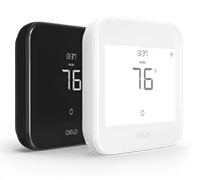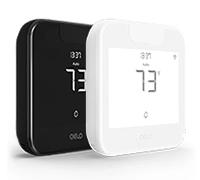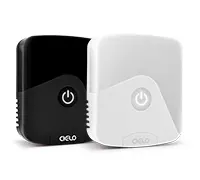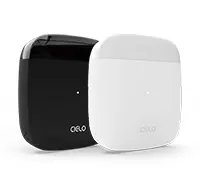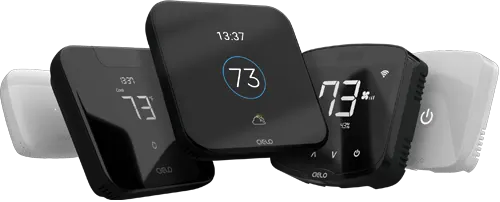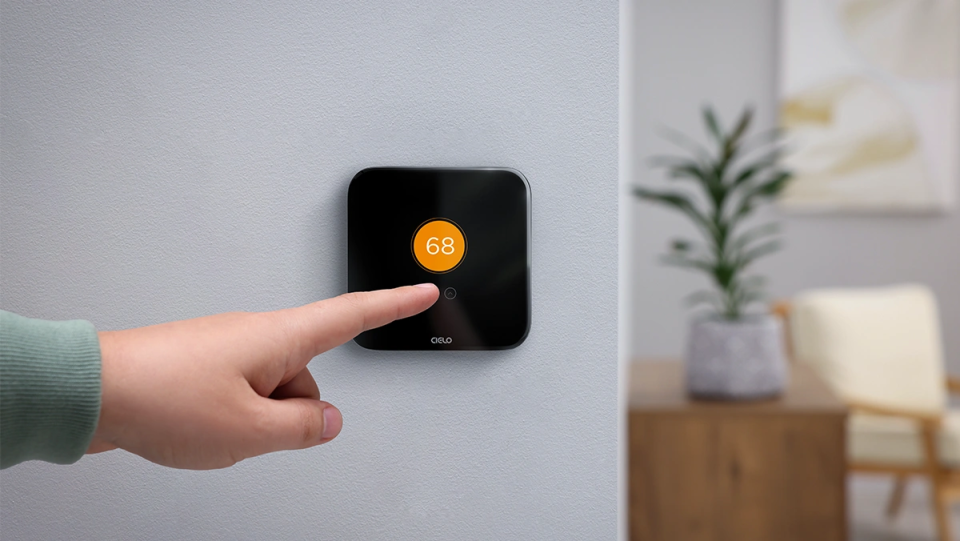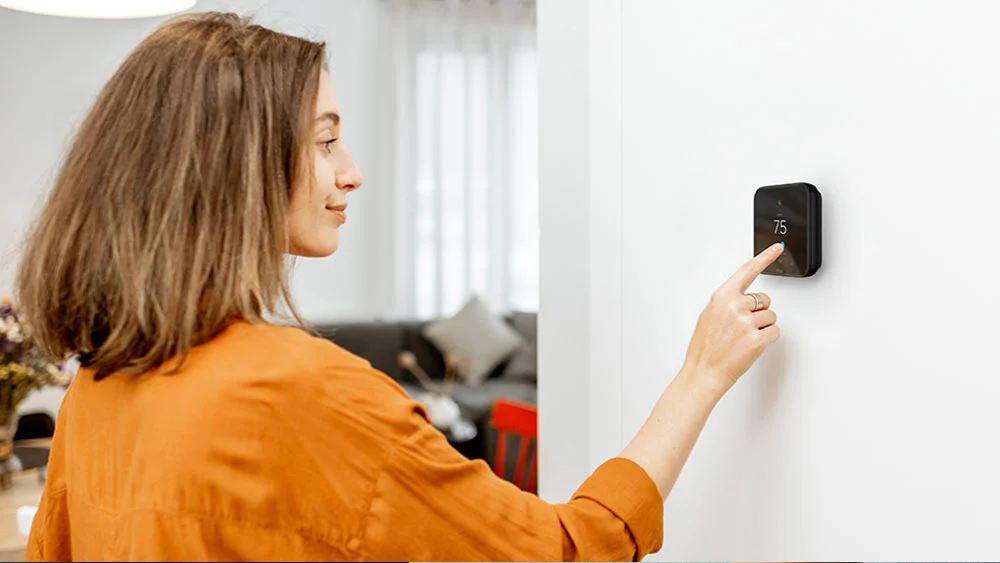
Key Takeaways
- The ideal humidity for sleep is 30%–50% as recommended by the EPA.
- Both high and low humidity disrupt sleep quality by causing nighttime discomfort.
- Smart thermostats with humidity monitoring make it easy to maintain optimal humidity levels.
When people think about achieving deep, comfortable sleep, they usually focus on temperature, mattress, or noise levels. Humidity rarely makes the list, even though maintaining ideal humidity plays a major role in how well you sleep. The amount of moisture in the air significantly affects your sleep quality, comfort, and long-term health. Whether you frequently wake up feeling stuffed up, dehydrated, sweaty, or uncomfortable, humidity levels could be the hidden cause.
So what exactly is the best humidity for sleeping? And how can you achieve it consistently? Let’s discuss everything you need to know about the best humidity for sleeping.
What is the Best Humidity Level for Sleeping?
The EPA recommends keeping indoor humidity between 30% and 50%, a range that supports both comfort and health. This level also helps maintain air quality, prevent mold, and regulate temperature more consistently.
To understand why good humidity is important for sleep, let’s first look at the sleep cycle.
Understanding the Sleep Cycle
A healthy adult experiences four stages of sleep. The first two stages, called non-rapid eye movement (NREM) sleep, are light sleep stages during which body temperature, breathing, heart rate, and brain activity gradually decline. Then comes the third stage of sleep, also known as slow-wave or deep sleep. The third stage is an essential restorative phase during which the body repairs tissue, strengthens muscles and bones, and boosts immune function.
The last stage of sleep is called the rapid eye movement (REM) sleep. During REM, your breathing and brain activity increase, your eyes move rapidly, and dreaming occurs. REM sleep is vital for cognitive functions such as learning, memory, and emotional processing.
How Does Humidity Impact Sleep?
Humidity plays a significant role in shaping how well you sleep because it influences your body’s ability to regulate temperature and move smoothly through the sleep cycle. When indoor humidity is too high or too low, your comfort, breathing, and overall sleep quality suffer too.
Effects of High Humidity on Sleep
Research shows high humidity can disrupt sleep. At 75% humidity, REM sleep and deep sleep (stage 3) dropped noticeably compared to the same temperature at 50% humidity. When the air is humid, your body struggles to cool down, which increases wakefulness and reduces time spent in both deep and REM sleep, the two stages essential for recovery and mental sharpness. This is especially true when summer indoor humidity rises, making the air feel heavier and more uncomfortable.
Indirect effects of high humidity include worsening asthma, triggering of bronchitis, and respiratory infections and irritation. Additionally, high humidity can lead to excessive sweating, making the bed feel stickier and more uncomfortable.
Effects of Low Humidity On Sleep
Low humidity, often below 30% also negatively impacts sleep. When the air is too dry, moisture evaporates more quickly from your skin, nose, and throat. This leads to irritation in the nasal passages. Dry air can also make the throat feel scratchy and tight, often increasing snoring and triggering nighttime coughing. As the nose dries out, the body produces extra mucus to compensate, causing congestion that disrupts sleep cycles and makes it difficult to stay asleep.
Your skin and eyes can also dry out, leaving you feeling itchy, restless, and less refreshed in the morning.
When Should You Raise or Lower the Humidity Level?
|
Increase Humidity When |
Decrease Humidity When |
|
Dry skin or eczema worsens overnight |
Mold or mildew spots appear in the bedroom |
|
You wake up with a dry nose or sore throat |
Bedsheets or pillows feel damp in the morning |
|
Static shocks from blankets or bedding are common |
Nighttime allergies or congestion get worse |
|
Wooden furniture, doors, or floors begin to crack |
Paint on the bedroom walls starts bubbling or peeling |
|
Eyes feel dry or irritated when waking up |
The room feels muggy, heavy, or uncomfortably warm during sleep |
Tips for Maintaining Optimal Sleep Humidity
In addition to keeping humidity in a healthy range and maintaining an ideal sleep temperature of around 60–68°F, you can use these simple strategies to create a more restful sleep environment.
-
Opt for a Smart Thermostat
A smart thermostat with humidity controls can help you maintain ideal humidity levels. Cielo smart thermostats come with built-in temperature and humidity sensors. They display real-time indoor humidity levels, helping you easily monitor your home’s humidity levels.
Cielo smart thermostats for mini-splits have a Comfy Humidity Mode, which automatically maintains optimal indoor humidity. Simply set your desired humidity range and the AC settings you want when levels go above or below it. Comfy Mode will then automatically make adjustments to keep humidity within your chosen range without requiring manual adjustments.
Your best choice to make any mini-split, window,
or portable AC smart. Enhance your comfort and savings.
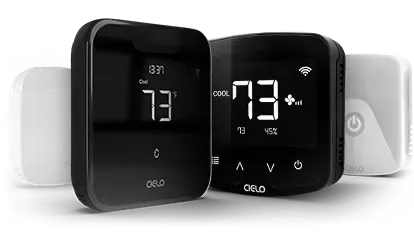
Cielo Smart Thermostat for central HVAC is compatible with whole-house humidifiers and dehumidifiers. While the thermostat itself doesn’t add or remove moisture, it automates the operation of the connected accessory, turning it on or off to maintain your set humidity levels.
Equip your HVAC system with smart features and achieve the perfect balance between comfort & savings.
Learn more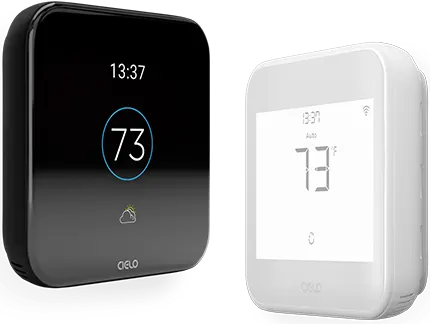
-
Use a Humidifier During Winters
If your room air feels dry and uncomfortable, especially in winter, a humidifier can raise indoor humidity to healthier levels. These devices release water vapors into the air, making breathing easier, reducing dry skin and throat irritation, and creating a more comfortable sleep environment. You can opt for a small room humidifier. Alternatively, you can also use a whole-home humidifier that integrates directly into your HVAC system and is regulated by a built-in humidistat.
-
Change the Fan Settings of Your Air Conditioner
Set your air conditioner’s fan to a moderate speed for better sleep. High fan speed can cause discomfort during sleep due to its high velocity and cold temperature.
Frequently Asked Questions
EPA recommends an ideal indoor humidity range of 30% to 50%. Maintaining this range helps prevent dry skin, irritated sinuses, and congestion, all of which can disrupt restful sleep. The best humidity level for a bedroom in winter is somewhere between 30% and 40%. This helps the air feel warmer, prevents dryness, and keeps your sleep environment comfortable without creating condensation or mold risks. If the air in your room is dry or you’re dealing with congestion, a humidifier is usually the better choice because it adds moisture that helps soothe your nose, throat, and skin. A fan, on the other hand, is better when you need to stay cool, but its constant airflow can worsen dryness and irritation if the air is already lacking moisture.
Is 50% Humidity Good for Sleep?
What Is the Best Humidity Level for Sleeping in Winter?
Is It Better to Sleep With a Fan or a Humidifier?
